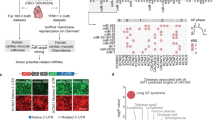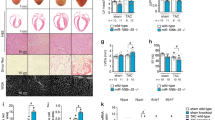Abstract
MicroRNAs (miRNAs) are endogenous noncoding RNAs, about 22 nucleotides in length, that mediate post-transcriptional gene silencing by annealing to inexactly complementary sequences in the 3′-untranslated regions of target mRNAs1,2,3. Our current understanding of the functions of miRNAs relies mainly on their tissue-specific or developmental stage-dependent expression and their evolutionary conservation, and therefore is primarily limited to their involvement in developmental regulation and oncogenesis2. Of more than 300 miRNAs that have been identified, miR-1 and miR-133 are considered to be muscle specific4,5,6. Here we show that miR-1 is overexpressed in individuals with coronary artery disease, and that when overexpressed in normal or infarcted rat hearts, it exacerbates arrhythmogenesis. Elimination of miR-1 by an antisense inhibitor in infarcted rat hearts relieved arrhythmogenesis. miR-1 overexpression slowed conduction and depolarized the cytoplasmic membrane by post-transcriptionally repressing KCNJ2 (which encodes the K+ channel subunit Kir2.1) and GJA1 (which encodes connexin 43), and this likely accounts at least in part for its arrhythmogenic potential. Thus, miR-1 may have important pathophysiological functions in the heart, and is a potential antiarrhythmic target.
This is a preview of subscription content, access via your institution
Access options
Subscribe to this journal
Receive 12 print issues and online access
$209.00 per year
only $17.42 per issue
Buy this article
- Purchase on Springer Link
- Instant access to full article PDF
Prices may be subject to local taxes which are calculated during checkout




Similar content being viewed by others
Change history
06 December 2011
In the version of this article initially published, lanes from the original blot shown in Figure 2b (NIZ and IZ samples, blotting for 55-kDa Kir2.1 and GAPDH) were rearranged in the published figure. The two lanes at the far right of the published blot were on the far left of the original blot, so that the sequence of the lanes in the original blot was as follows (from left to right): IZ (WT miR-1 + AMO-1), IZ (MT miR-1), NIZ, IZ, IZ (AMO-1), IZ (WT miR-1). We have added white space to indicate that the blot is not continuous in the HTML and PDF versions of the article.
06 December 2011
Editors' note: With regard to the above article, the editors wish to notify readers of Nature Medicine that the Montreal Heart Institute announced on 2 September 2011 that an investigation had found evidence of misconduct in publications from the laboratory of Zhiguo Wang at that institution. The committee in charge of this investigation recommended that several publications from Z. Wang's laboratory be retracted (some of which had already been retracted over the summer); in addition, his laboratory at the Montreal Heart Institute was closed. One of the papers investigated was the Nature Medicine paper listed above, for which the corresponding authors were Z. Wang (affiliated with the Harbin Medical University, China and the Montreal Heart Institute, Canada) and Baofeng Yang (affiliated with the State-Province Key Laboratories of Biomedicine-Pharmaceutics of China and the Institute of Cardiovascular Research, Harbin Medical University, China). The investigating committee's report stated that they did not find evidence of misconduct for the data in the Nature Medicine paper that was generated at the Montreal Heart Institute; namely, Figure 1a ("CAD human" data only) and Figure 2f,g. According to the report, the remaining data in the paper were not generated at the Montreal Heart Institute and were not investigated. In correspondence with Nature Medicine, both Z. Wang and Yang stand by the data in the Nature Medicine paper. However, Z. Wang noted that, for Figure 2b, lanes from the original blot had been rearranged in the published figure, for which we are publishing a Corrigendum in this issue.
References
Meister, G. & Tuschl, T. Mechanisms of gene silencing by double-stranded RNA. Nature 431, 343–349 (2004).
Alvarez-Garcia, I. & Miska, E.A. MicroRNA functions in animal development and human disease. Development 132, 4653–4662 (2005).
Miranda, K.C. et al. A pattern-based method for the identification of microRNA binding sites and their corresponding heteroduplexes. Cell 126, 1203–1217 (2006).
Rao, P.K., Kumar, R.M., Farkhondeh, M., Baskerville, S. & Lodish, H.F. Myogenic factors that regulate expression of muscle-specific microRNAs. Proc. Natl. Acad. Sci. USA 103, 8721–8726 (2006).
Zhao, Y., Samal, E. & Srivastava, D. Serum response factor regulates a muscle-specific microRNA that targets Hand2 during cardiogenesis. Nature 436, 214–220 (2005).
Chen, J.F. et al. The role of microRNA-1 and microRNA-133 in skeletal muscle proliferation and differentiation. Nat. Genet. 38, 228–233 (2006).
Clements-Jewery, H., Hearse, D.J. & Curtis, M.J. Phase 2 ventricular arrhythmias in acute myocardial infarction: a neglected target for therapeutic antiarrhythmic drug development and for safety pharmacology evaluation. Br. J. Pharmacol. 145, 551–564 (2005).
Ghuran, A.V. & Camm, A.J. Ischaemic heart disease presenting as arrhythmias. Br. Med. Bull. 59, 193–210 (2001).
Krutzfeldt, J. et al. Silencing of microRNAs in vivo with 'antagomirs'. Nature 438, 685–689 (2005).
Cheng, A.M., Byrom, M.W., Shelton, J. & Ford, L.P. Antisense inhibition of human miRNAs and indications for an involvement of miRNA in cell growth and apoptosis. Nucleic Acids Res. 33, 1290–1297 (2005).
Kitsis, R.N., Buttrick, P.M., McNally, E.M., Kaplan, M.L. & Leinwand, L.A. Hormonal modulation of a gene injected into rat heart in vivo. Proc. Natl. Acad. Sci. USA 88, 4138–4142 (1991).
Rajan, S., Radhakrishnan, J. & Rajamanickam, C. Direct injection and expression in vivo of full-length cDNA of the cardiac isoform of alpha-2 macroglobulin induces cardiac hypertrophy in the rat heart. Basic Res. Cardiol. 98, 39–49 (2003).
Sarkar, N. et al. Nonsurgical direct delivery of plasmid DNA into rat heart: time course, dose response, and the influence of different promoters on gene expression. J. Cardiovasc. Pharmacol. 39, 215–224 (2002).
Jongsma, H.J. & Wilders, R. Gap junctions in cardiovascular disease. Circ. Res. 86, 1193–1197 (2000).
Diaz, R.J. et al. Selective inhibition of inward rectifier K+ channels (Kir2.1 or Kir2.2) abolishes protection by ischemic preconditioning in rabbit ventricular cardiomyocytes. Circ. Res. 95, 325–332 (2004).
Yue, P. et al. Ischemia impairs the association between connexin 43 and M3 subtype of acetylcholine muscarinic receptor (M3-mAChR) in ventricular myocytes. Cell. Physiol. Biochem. 17, 129–136 (2006).
Lerner, D.L., Yamada, K.A., Schuessler, R.B. & Saffitz, J.E. Accelerated onset and increased incidence of ventricular arrhythmias induced by ischemia in Cx43-deficient mice. Circulation 101, 547–552 (2000).
Guerrero, P.A. et al. Slow ventricular conduction in mice heterozygous for a connexin43 null mutation. J. Clin. Invest. 99, 1991–1998 (1997).
McLerie, M. & Lopatin, A.N. Dominant-negative suppression of IK1 in the mouse heart leads to altered cardiac excitability. J. Mol. Cell. Cardiol. 35, 367–378 (2003).
Sayed, D., Hong, C., Chen, I.-Y., Lypowy, J. & Abdellatif, M. MicroRNAs play an essential role in the development of cardiac hypertrophy. Circ. Res. 10.1161/01.RES.0000257913.42552.23 (2007).
Van Rooij, E. et al. A signature pattern of stress-responsive microRNAs that can evoke cardiac hypertrophy and heart failure. Proc. Natl. Acad. Sci. USA 103, 18255–18260 (2006).
Yang, B. et al. Choline produces cytoprotective effects against ischemic myocardial injuries: evidence for the role of cardiac M3 subtype muscarinic acetylcholine receptors. Cell. Physiol. Biochem. 16, 163–174 (2005).
Curtis, M.J. & Walker, M.J. Quantification of arrhythmias using scoring systems: an examination of seven scores in an in vivo model of regional myocardial ischemia. Cardiovasc. Res. 22, 656–665 (1988).
Salameh, A. et al. Chronic regulation of the expression of gap junction proteins connexin40, connexin43, and connexin45 in neonatal rat cardiomyocytes. Eur. J. Pharmacol. 503, 9–16 (2004).
Acknowledgements
We thank X. Yang for technical support and M.-A. Lupien for handling human tissues. This work was supported in part by the Canadian Institute of Health Research and Fonds de la Recherche de l'Institut de Cardiologie de Montreal (to Z.W.) and by the National Nature Science Foundation of China (30430780) and the Foundation of National Department of Science and Technology of China (2004CCA06700) (to B.Y.). Z.W. is a senior research scholar of the Fonds de Recherche en Sante de Quebec.
Author information
Authors and Affiliations
Contributions
B.Y. and Z.W. supervised the project and wrote the manuscript; H.L. and J.X. designed the experiments and conducted the luciferase and real-time RT-PCR experiments; X.L., B.L. and H.W. performed a part of the luciferase and western blot analysis; Y.B. and C.X. conducted patch-clamp recordings; Y.L., Y.Z. and G.C. designed and conducted the animal studies.
Corresponding authors
Ethics declarations
Competing interests
The authors declare no competing financial interests.
Supplementary information
Supplementary Fig. 1
The complementary sequences between miR-1 and its putative sites within the 3′UTRs of human (H), rat (R) and mouse (M) GJA1 and KCNJ2 mRNAs, predicted with computational and bioinformatics-based approach using TargetScan hosted by Wellcome Trust Sanger Institute11. (PDF 176 kb)
Supplementary Fig. 2
Comparisons of connexin43 (Cx43) and Kir2.1 protein levels between membrane samples isolated from individuals with healthy control hearts (HH) and from individuals suffered from coronary artery diseases (CAD), determined by Western blot analysis. (PDF 105 kb)
Supplementary Fig. 3
Examination of the specificity of the anti-miR-1 antisense inhibitor oligonucleotides (AMO-1) to target miR-1 and miR-1 actions on arrhythmias and the protein levels of Cx43 and Kir2.1, using a negative control AMO-1 (AMO-1 with ten mismatched nucleotides, Mis-AMO-1). (PDF 123 kb)
Supplementary Fig. 4
Verification for the lack of effect of miR-1 on KCNH2 (encoding HERG K+ channel) expression, serving as negative control experiments for GJA1 and KCNJ2, and verification for the effectiveness of miRNAs and AMO-1 used in our study. (PDF 160 kb)
Supplementary Fig. 5
Representative images showing successful uptake and distribution of exogenous miR-1 (50 μg in 100 μl) 12 h after multiple-site (∼10 sites) intramuscular injection into the myocardium. (PDF 1826 kb)
Supplementary Table 1
Characteristics of individuals from whom the human ventricular preparations were obtained for use in the present study (PDF 71 kb)
Supplementary Table 2
Changes of QRS duration and QT interval in rat hearts with intramuscular injection of various constructs (PDF 96 kb)
Rights and permissions
About this article
Cite this article
Yang, B., Lin, H., Xiao, J. et al. The muscle-specific microRNA miR-1 regulates cardiac arrhythmogenic potential by targeting GJA1 and KCNJ2. Nat Med 13, 486–491 (2007). https://doi.org/10.1038/nm1569
Received:
Accepted:
Published:
Issue Date:
DOI: https://doi.org/10.1038/nm1569
This article is cited by
-
MiR-181a protects the heart against myocardial infarction by regulating mitochondrial fission via targeting programmed cell death protein 4
Scientific Reports (2024)
-
Integrated modeling framework reveals co-regulation of transcription factors, miRNAs and lncRNAs on cardiac developmental dynamics
Stem Cell Research & Therapy (2023)
-
The role of miR1 and miR133a in new-onset atrial fibrillation after acute myocardial infarction
BMC Cardiovascular Disorders (2023)
-
The important role of miR-1-3p in cancers
Journal of Translational Medicine (2023)
-
ADSC-derived exosomes attenuate myocardial infarction injury by promoting miR-205-mediated cardiac angiogenesis
Biology Direct (2023)



